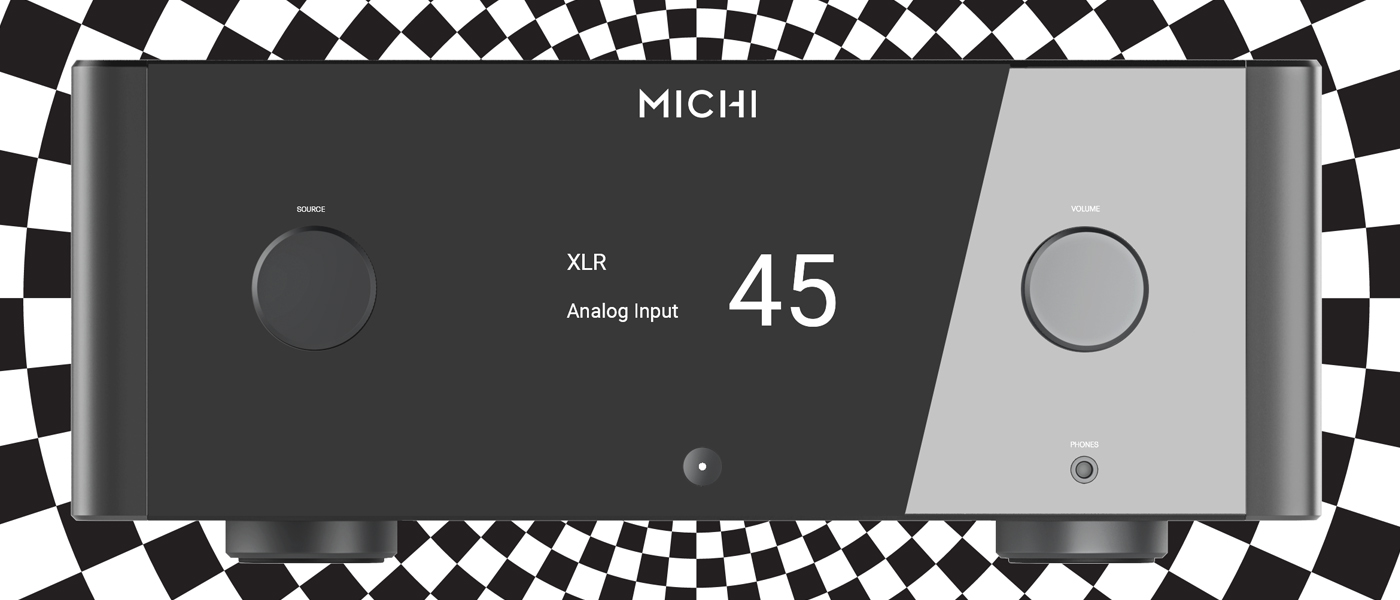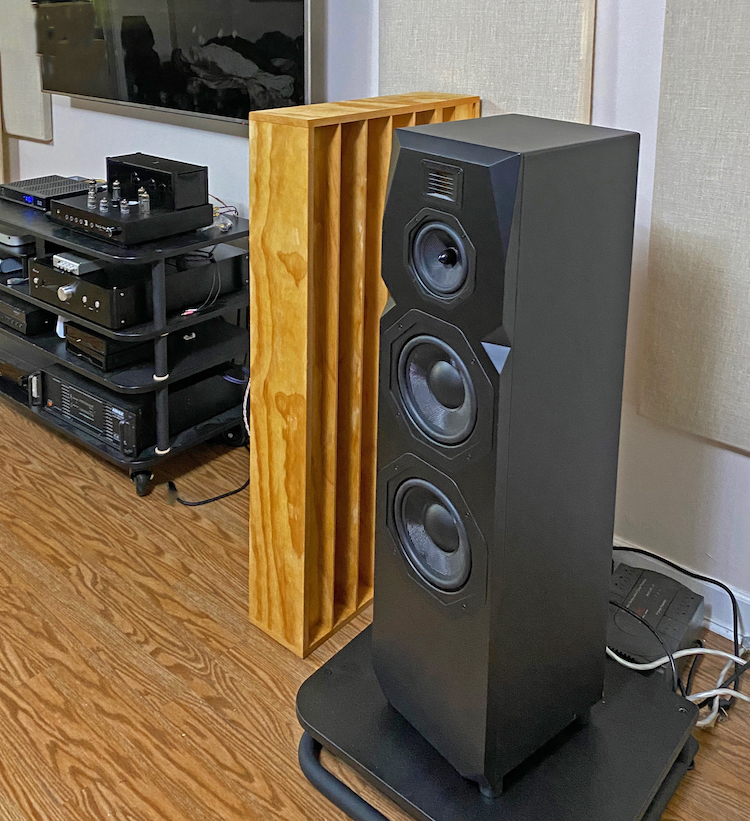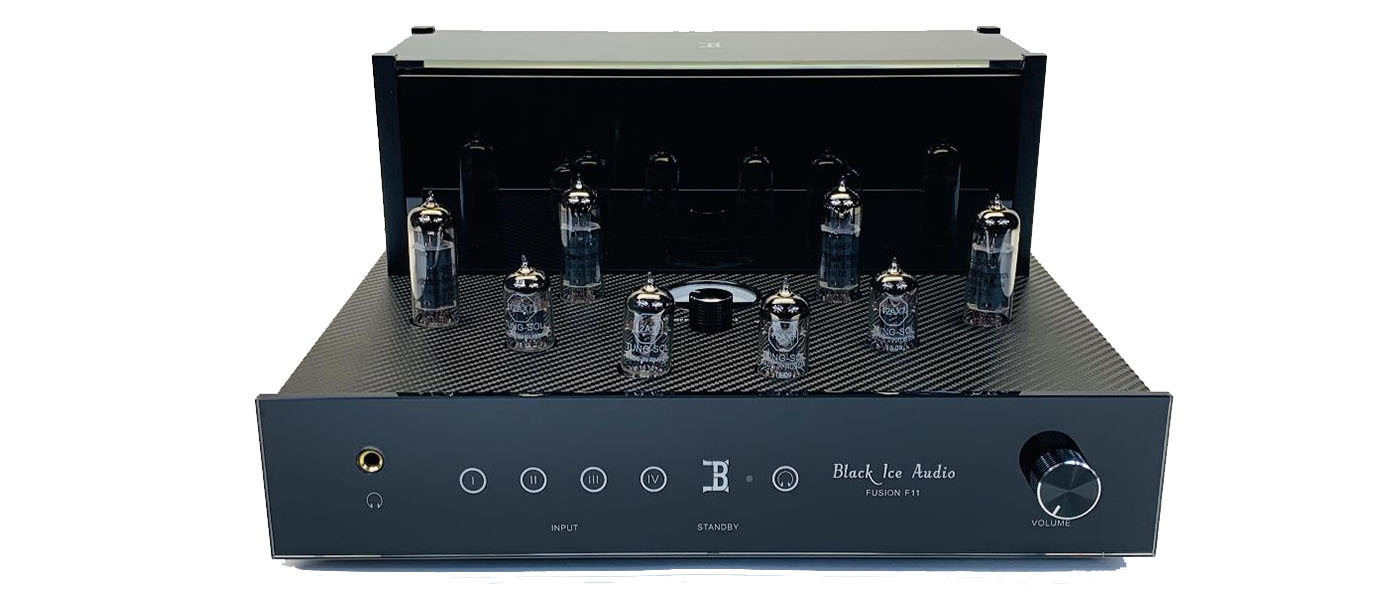
The Black Ice Fusion F11 Vacuum Tube Integrated Amplifier (henceforth, the F11) is an extremely well-made integrated amplifier with 18.5 watts per channel.
So, let’s get the obvious out of the way – this isn’t the amplifier to power your Saturday night frat-house party, 18.5 watts only go so far. On the other hand, remember that 99% or more of your living room listening is done at one watt or less. No, I’m not making that up and yes, I’m sure that I’m right. The only exception would be those of you who like to listen at blow-out-the-walls levels, and if you fit that category, then you’re already deaf, and need not read any further. For the rest of us, the F11 has quite a lot to offer.
Secrets Sponsor
Ignoring, for the moment, the exceptionally good construction, and ignoring the amplifier’s exceptional convenience and attractiveness, the F11 just plain sounds good. How good? VERY good. Even driving less efficient speakers, the warm and detailed tone of the F11 is sure to be a hit with many listeners. And if you DO have efficient speakers (essentially any speaker with at least 90dB @ 1w/1m output), then the dynamics of the F11 amplifier will definitely amaze you.
BLACK ICE FUSION F11 VACUUM TUBE INTEGRATED AMPLIFIER
F11 Virtues and Vices:
- Exceptional construction quality with parts normally found on products costing twice as much
- Attractive appearance with lots of lights and a bias meter
- Bias adjusting screwdriver included
- To totally darken the lights, one must turn the power switch (behind the amp) off
- Tubes are top quality
- A remote control is included
The F11 comes packed in custom cut foam with the tubes cradled in their own recesses. The box also contains a remote control with batteries, a bias screwdriver, a pair of gloves, and a fabric amplifier cover. The owner’s manual claims that Mr. Jim Fosgate is the designer of the F11, and references his experience, although Mr. Jerrerd Dunkerson provided feedback on the sonics. The F11 boasts an “Odyssey” circuit design that uses a “fully differential push-pull architecture” – more on this later.
The Black Ice Fusion F11 Vacuum Tube Integrated Amplifier uses some of the best parts I’ve ever seen on a mass-production device. I’m suspecting that the use of a backplane printed circuit board is what allows the manufacturer’s budget for such lavish quality circuit components. In other words, since the company doesn’t have to spend so much on hand-wiring (and subsequent circuit tracing to make sure that the wiring is right), the money saved on physical construction frees the funds needed to buy Nichicon electrolytic capacitors, close-tolerance metal-film resistors, and film capacitors custom made for Black Ice Audio in the signal path.
Do those premium components provide audible benefits? I think they do. Having soldered my own tube components for decades, I’m convinced that better components (particularly metal film resistors and film capacitors) provide not only quieter circuitry but also smoother and more dynamic sounding audio output.
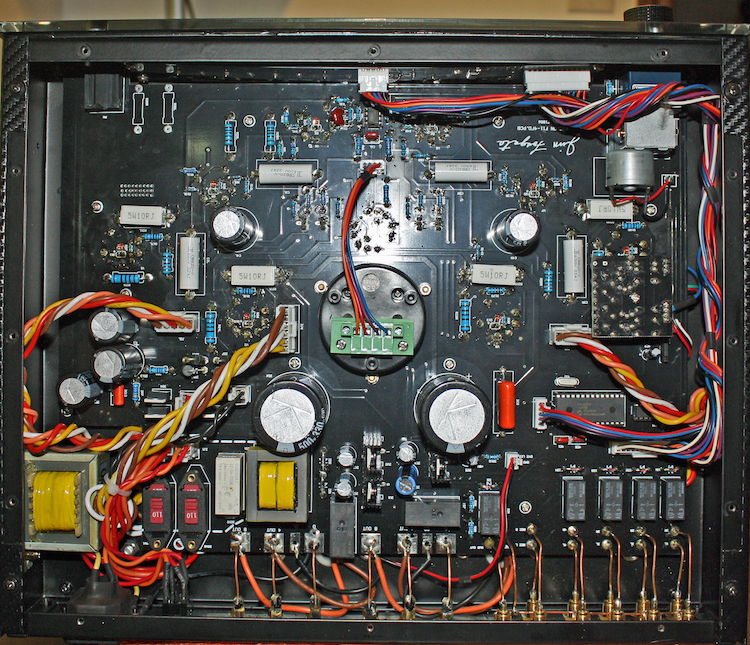
The F11 has a glass front panel and transformer cover. Controls, except for the volume knob, are touch activated and a remote is included. For biasing, the amp has a top-mounted meter with an adjusting-screw for each tube. And a word about tube quality is earned here – NONE of the tubes in the amplifier were the least bit microphonic. I could lightly tap each and every tube with a pencil and hear NOTHING out of the speakers. That’s VERY good tube performance. I normally have to use tube dampers that look like a miniature life-preserver around each of the input tubes, but no dampers were needed here.
All output tubes are rated for 3,000 hours of service, and the smaller 12AX7A driver tubes are rated for 6,000. The recommended bias for the output tubes is 30 milliamperes (ma) 3ma. The EL84 output tubes sound far more muscular, particularly in the bass, than one would expect for an amplifier producing a mere 18.5 watts for each channel. Part of the credit must go to the output transformers (based on a David Halfler design). But the other part of the credit must reside with the EL84s. These are excellent output tubes and I’ve liked their sound in almost every single amplifier that I’ve ever heard them in. I’m also fond of the more muscular EL34 tubes and these are used in the F11’s bigger brother, the Black Ice Audio F22 Fusion amplifier.
Lights abound, whether you like them or not… In addition to the white-lighted “Black Ice Audio” script on the amplifier’s front panel, and the lighted Black Ice logo on the same panel (that doubles as the on/standby switch), an additional pilot light is placed atop the transformer cover box. Even in standby mode, the on/off logo, pilot light, and “Black Ice Audio” logo remains lit. I find this distracting when the amp is not even playing and wish these lights were defeatable, but many won’t care. As delivered, the only way to turn off all amplifier lighting is to use the on/off switch on the back of the amplifier that may be less than readily accessible in some equipment racks.

The quarter-inch headphone jack sounds really good with both my Audio-Technica and Koss headphones, and the speakers can be muted if desired while listening through headphones.
The remote control did have two issues to which I objected. First, the volume change per button click was rather coarse. One level was slightly too soft, but the next increase in volume from the remote control made the music too loud. More and finer steps would have been nice.
The second issue is, despite the remote’s heavy metal construction and the chromed buttons having a good feel, there was no backlighting. Perhaps I’m spoiled but I think all remotes should have motion-activated backlighting. That way, if I’m listening in the dark, and want to know where I left the remote, I can just slap the couch cushion, and the handset lights up to identify its location. The lighting complaint is trivial; the volume change issue is not.
MAXIMUM POWER OUTPUT:
23 watts per channel @ 8 Ohms, 1KHz with EL84 tubes
RATED OUTPUT POWER:
18.5 watts per channel @ 8 Ohms, 25Hz to 60kHz with EL84 tubes
FREQUENCY RESPONSE:
8Hz to 130kHz +1dB @ 1 watt/8 Ohms
BANDWIDTH:
15Hz to 80kHz +3dB; 0dB 19w 1khz
DISTORTION THD:
Less than 1% at 20V output, 28Hz to 15kHz
CIRCUIT TYPE:
Fully Balanced Differential Push-Pull
INPUT IMPEDANCE:
100K Ohms
INPUT SENSITIVITY:
1V @ 1kHz for 0-watt output
OUTPUT IMPEDANCE TAPS:
4 & 8 Ohms
NEGATIVE FEEDBACK:
Less than 4.5dB
NOISE & HUM:
95dB below rated output
TUBES:
4x EL84 Power Output & 4x 12AX7A/ECC83
POWER REQUIREMENTS:
110-120VAC, 60Hz – 6 watts standby, 350 watts maximum (220VAC 50Hz option)
DIMENSIONS:
14.5 inches wide x 11.5 inches deep x 7.5 inches high
WEIGHT:
30 pounds net, approximately 43 pounds packaged
WARRANTY:
Chassis & transformers = 2 years / Tubes = 1 year or 1,000 hours whichever comes first
BIAS SETTINGS:
30 milliamps 3mA for EL84s
FUSE:
110-120VAC, 6.3amp slo-blo; 200-240VAC, 3.15amp slo-blo
FUSE SIZE:
5x20mm
INPUT SWITCHING:
Via panel touch control or remote
RCA OUTPUTS:
Fixed and Subwoofer (mono)
ON/OFF SWITCHING:
Via panel touch or remote
HEADPHONE:
¼” Jack with tube amplification
TRANSFORMERS:
Custom-wound with German, grain-oriented silicon steel. Based on the Halfler design
BIAS METER:
top panel terminal with tube selection switch and lighted meter
COMPONENTS:
Alps Blue volume control, gold plated RCA jacks, Black Ice coupling caps
COLOR:
Available in silver or black
PRICE:
$1,499 USD
Website:
Company Directory:
SECRETS Tags:
Integrated amplifier, f11, tube amp, Black Ice, Jim Fosgate, Mike Allen, Jerred Dunkerson, 2020, Review 2020
- Black Ice Audio Glass-Fx Tube Dac
- Manley Stingray tube integrated amplifier
- Ming DA-MD-75 tube integrated amplifier
As part of the review, I interviewed Mr. Jerred Dunkerson of Black Ice Audio. My questions and his responses are listed below:
A: The goals of the Fusion F11 amplifier design were:
- To use Jim Fosgate’s Odyssey circuit to simplify the amplifier.
- To reduce production costs by the use of printed circuit boards and use the savings to improve parts quality and to provide the best performance at this price.
- To provide the sound of tubes with the reliability of solid-state.
- To use the best quality parts within the available budget.
- To use current and readily available tubes.
- To make the amplifier’s appearance as attractive as possible while maintaining a good internal design.
- To use the most user-friendly design possible.
The F11 is intended to work with any speaker of 87dB @ 1w/1m or more. The F11 has won awards via AV Showrooms while driving Vienna Grand Beethoven speakers, but the factory recommendation is to use speakers of 90dB or more sensitivity.
A: The lights are intended as pilot LEDs and run from their own separate transformer. While in standby, the remote can be used to wake the amplifier.
A: This is a new circuit designed by Jim Fosgate. He calls it a “Dual-phase, V-drive circuit with only two gain stages.” Adjustment to the output tube bias also adjusts the 12AX7 tubes’ bias. The amplifier uses only 4.5dB feedback and has no specific soundstage enhancement circuitry, despite throwing one of the widest and deepest images I’ve heard.
The amplifier has very strong bass. It’s almost like listening to Beats headphones, but without the mid-bass peak. But despite this, no specific EQ is used, and the bass is not at all overly prominent with most speakers. The bass of the F11 is, however, VERY tight, controlled, and revealing of pitch. Both my Emotiva T2 speakers and my Tekton-Design Double Impact speakers exhibited fantastically great bass with the F11.
The headphone amp socket comes directly off the F11’s output transformers and can be used with or without the loudspeaker output taps active.
Equipment Used during this review:
- Roon nucleus+ music streamer with USB & Qobuz music libraries
- Audioquest Dragonfly Black 1.5 DAC
- Audioquest and Kimber Kable DAC to F11 cables
- Kimber 4TC speaker cables
- Emotiva T2 speakers
- Tekton Design Double Impact speakers

Grieg – Piano Concerto in A Minor Op. 16 by Budapest Philharmonic conducted by Peter Wohlert with Yuri Ahronovitch, piano.
This recording on the much-maligned LaserLight label is one of my favorite performances of this concerto. Through the F11 amp, it sounded more open and spacious than I’ve ever heard it sound before; I suspect this is due to the “Odyssey” circuitry in the F11. The soundstage was exceptional and with the Emotiva speakers, the frequency response seemed smooth from the lowest to the highest notes. Since the recording itself is not the very best quality, the F11 amplifier apparently just happened to enhance those parts of the recording that needed enhancing. This is the best I’ve heard this recording sound.

“Dixie Chicken”, Waiting For Columbus, Little Feat
Another of my perennial favorites is Little Feat’s “Dixie Chicken” from their “Waiting For Columbus” album. As with most live recordings, the upper midrange and treble can get out of hand at a couple of points in the performance. The F11 amplifier seemed to put an additional and undue emphasis on the “hot spots” of the recording, making them either “turn it down” or else “put your fingers in your ears” moments. At lower volumes, this wasn’t an issue, leading me to wonder if my room was contributing more to the glare than the amplifier – so take this complaint with a grain of salt.
If the recording is a good one, the F11’s slight spotlight on the upper midrange to lower treble is completely inoffensive. But if the recording has problems in this frequency range, the amplifier seems to focus on those issues. It sounds like some of the infamous “Sabre Glare” that was once attributed to Sabre DACs, and indeed, since the Audioquest Dragonfly DAC does use a Sabre DAC, this glare may partially be an artifact of the DAC as well as the amplifier.
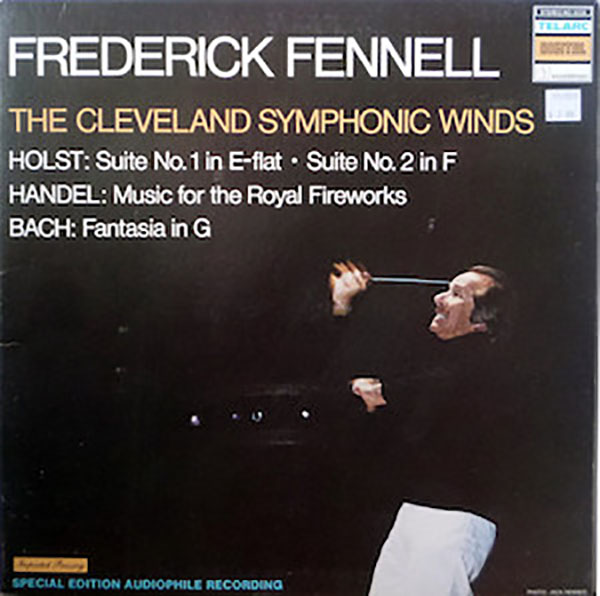
Holst, Frederick Fennell and the Cleveland Wind
The old Telarc recording of Frederick Fennell and the Cleveland Winds playing Holst is one of my favorite discs. The dynamics are typical Telarc and the detail is very good. The F11 kept the orchestral details pristine with bells, cymbals, and triangles that floated above the orchestra as they seem to in live performances. Many amplifiers lose the prominence of these struck percussion instruments and allow the leading edges to blur back into the orchestra’s string sound. The F11 amplifier does an excellent job of avoiding the loss of the percussion’s impact. The remainder of the orchestra is clean and sounds both deep and broad. And the timpani rock the room!

“Safe in the Arms of Love”, Martina McBride
“Safe in the Arms of Love” by Martina McBride is a guilty favorite. A simple song, but well performed and recorded, I enjoy it from time to time; and it has never sounded better than through the F11 amplifier.

“Christmas”, Singers Unlimited
The album “Christmas” by Singers Unlimited provides harmony that challenges most amplifiers. If the voices blend too much, then some of the immediacy of the performance is lost. With the F11 amplifier, each singer’s voice appeared in the soundstage as separate and distinct from the others. The harmonies took on greater clarity when soloists appeared, “Good King Wenceslas,” for example. Their voices have no distortion or wolf tones, even at higher volumes. Aside from the previously mentioned “Good King Wenceslas,” my other favorites on the album are “Caroling, Caroling” and “Wassail Song.” These are demo-worthy tracks for both their recording quality and their excellent performances.

“How Great Thou Art”, Valor
The song “How Great Thou Art” is an almost frightening use of the “frequency divider circuit” that allows tones (the bass singer’s voice, in this case) to be presented at half the frequency of the fundamental. Those who have truly full-range speakers (or use a capable subwoofer) can enjoy the novelty of wall-shaking bass when low notes come along. Valor plumbs the depths in this song, and most systems will be only hinting at the lowest notes. Although my Emotiva T2 speakers fit into the “most systems” category with this song, the Tekton Double Impact speakers are another story altogether.
With only the 18.5-watt F11 amplifier driving them, the Tekton speakers absolutely FILLED my large room with shuddering bass. And not only was there extension and quantity, but the F11-Double Impact combo also maintained pitch definition all the way down! None of my much more powerful solid-state amplifiers could come close. Why is the F11 amplifier so accomplished in the bass? Black Ice Audio claims it’s the “Odyssey” circuitry that makes the difference. I can’t argue with them on that, but the results speak for themselves – the F11 handles this better than any other amp I’ve heard.

“Autobahn”, The Mix, Kraftwerk
The remastered and full-length version of the German synth-meisters’ “Autobahn” from their “The Mix” CD stands as a classic and much-admired example of “electronic music,” as it was called in the 1970s. There are plenty of details in the mix that the F11 amplifier does a good job of highlighting. A friend of mine, who was a Volkswagen mechanic back in the day once heard the engine start and drive-off sequence at the beginning of this track and without hearing any more declared “I’m buying that album!”
Secrets Sponsor
With many systems, the rhythmic nature of the background motif can be almost sleep-inducing, but the F11 amplifier makes each of the variations introduced both novel and attention-getting, even if you’ve heard the track many times before. Similarly, on the “Radioactivity” track of this album, the F11 intimates the “Morse Code” sound of vacuum-tube electronic circuits early in the song. The F11 highlights the subtle differences in tonal shadings better than any of my solid-state amplifiers.
The Black Ice Audio Fusion F11 Integrated Amplifier is one of the best-made and best-sounding tube amplifiers that I’ve heard at any price.
- Spacious sound field
- Well-controlled and ample bass particularly for bookshelf speakers
- Tolerant of analog or digital equalization
- Great looks
- Amazingly high-quality construction
- Affordable price for the sound quality
- Owner’s manual without errors
- Fewer lights on in standby mode
- Slightly deeper speaker jacks
- Finer steps in volume control via remote
The Black Ice Audio Fusion F11 tube integrated amplifier is one of the best introductions to tube amplification that I’ve found. For $1,500, one gets a taste of what the highest of high-end tube amps are about and with absolutely NONE of the temperamental hiss, hum, tube microphonics, or second-order distortion that many cheap imported amps exhibit. For someone who wants to decide if tubes are for them, I can’t think of a better choice than the F11. I’d further wager that most customers who buy this amplifier as a trial won’t ever sell it. It’s that good.


